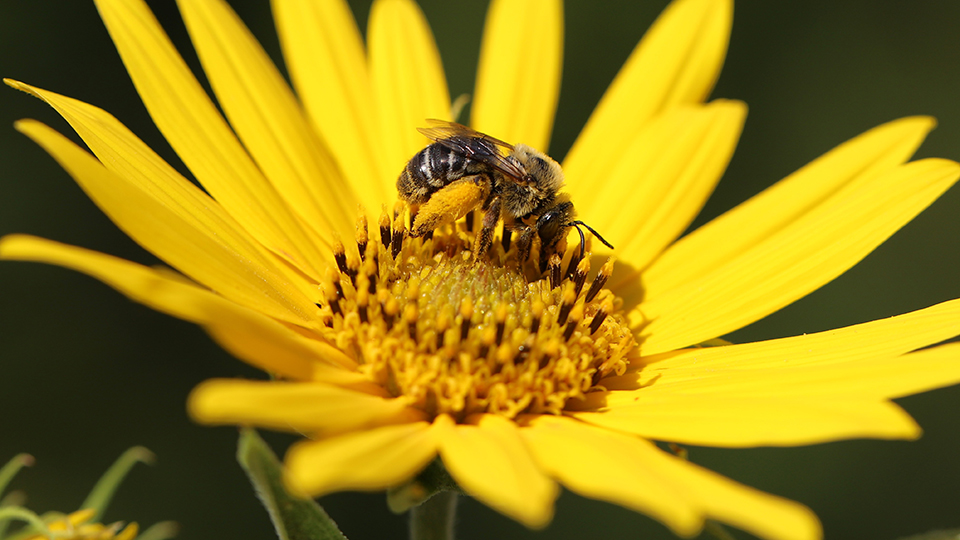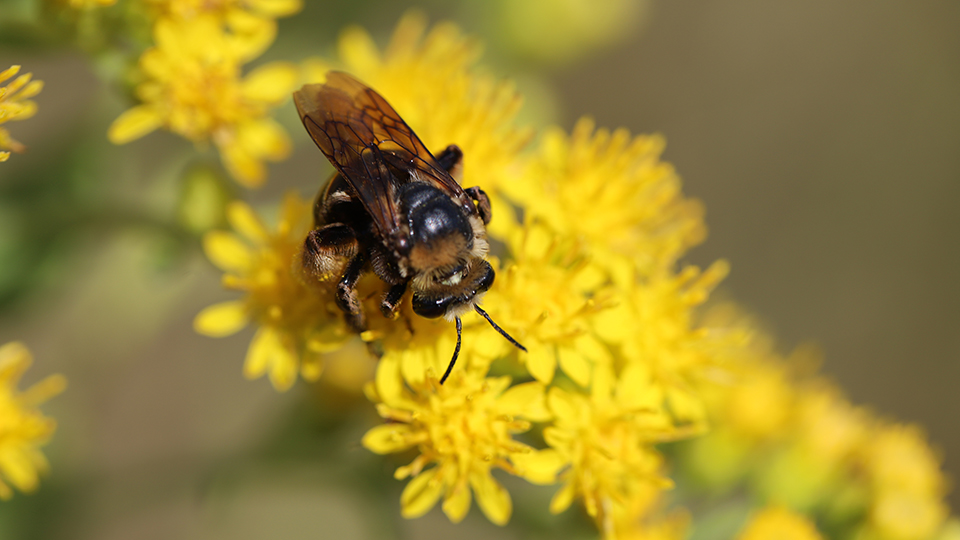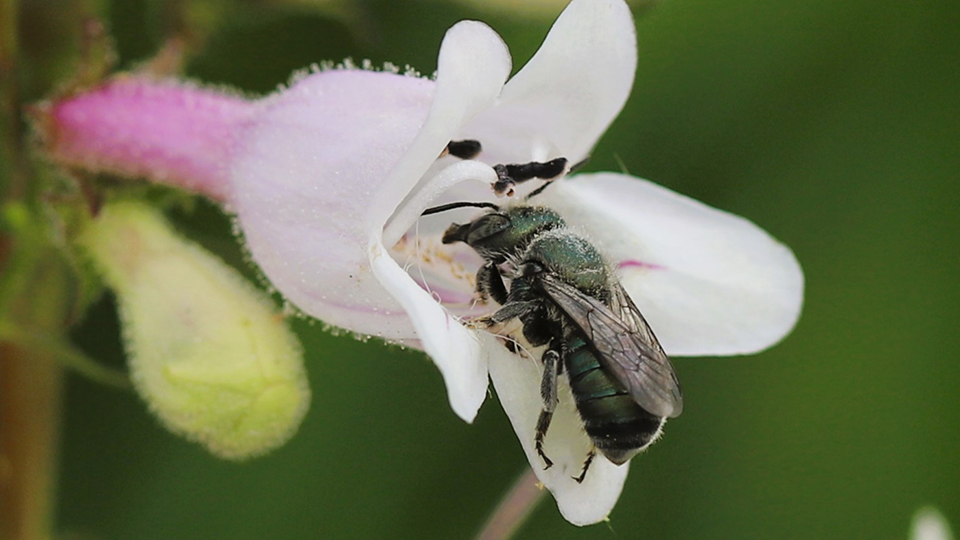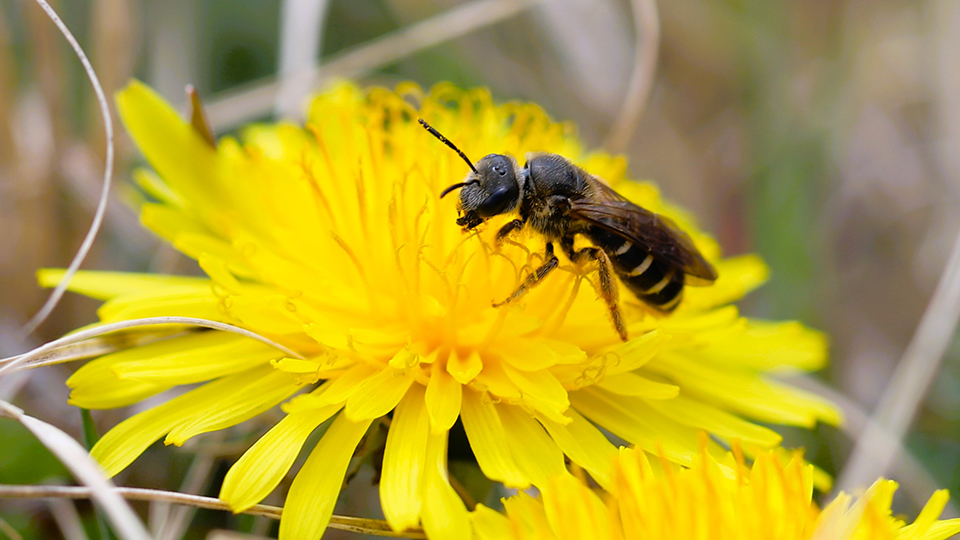How a K-State researcher is using AI and ‘citizen scientists’ to spread knowledge and protect bees
When most people think of “bees,” they think of black and gold striped honey bees
producing honey in a hive, or maybe even a fuzzy bumble bee resting on a brightly-colored
flower in a garden.
However, there’s a great deal of depth in the study of the Earth’s bee populations
— there are over 400 species of bees in Kansas alone; 4,000 different species in North
America; and 20,000 worldwide.
“Most people just see tiny little bees, and they think they're all the same thing.
And I don’t blame them, because they're just so hard to see,” says Brian Spiesman,
assistant professor in the K-State Department of Entomology. “If they have a garden
or just a few flowers, there's probably a good 50 different species over the course
of the summer that will be visiting flowers in your garden.”
As pollinators, bees play a critical role in the ecosystem, both locally and globally,
and the threat of declining bee populations has generated many news headlines. As
an ecologist specializing in the study of bees, Spiesman is passionate about educating
the public and protecting vulnerable species. And he’s using a unique combination
of research, artificial intelligence and “citizen scientists” to do it.
What is BeeMachine?
According to Spiesman, bees are the most important pollinators on the planet.
“Without bees, there goes a good 80% of plant life,” he said. “And without plants,
you don't have the entire ecosystem that's dependent on plants, all of the animals
and birds and other insects.”
Spiesman’s research focuses on native wild bees, which range in size from large bumble
bees down to tiny sweat bees.
“We don't know a lot about the status of a lot of those different species, just because
they're so difficult to identify, and not a lot of people take the time to, even ecologists
and entomologists,” he said. “We are often just counting the number of species when
we go out and we do work in prairies or something like that, but we don't really identify
which ones are there, and that's important to know, so that we can start tracking
individual species and see where they're going up and where they're going down, and
try to get a better handle on the causes of declines of different species.”
Enter BeeMachine, a powerful AI interface that allows anyone — whether they’re a researcher or an
average citizen — to snap a photo of a bee and then use the app to identify the species.
Users can map their sightings and discuss them with other BeeMachine users, contributing
to an open database for wild bee conservation science.
BeeMachine was developed by Spiesman in collaboration with William Hsu, professor
in K-State’s Department of Computer Science; Brian McCornack, professor and head of
K-State’s Department of Entomology; and Claudio Gratton, professor at the University
of Wisconsin - Madison.
Spiesman said that BeeMachine’s artificial intelligence algorithms are limited only
by the breadth of data they have access to, and so the more photos and information
that are uploaded to the BeeMachine app, the more the computer models can be trained
to recognize different bees.
“Getting started with it, I was thinking of it mainly as a tool for scientists,” Spiesman
said. “But it's a tool for everybody, and I have started to realize it can be a really
powerful way to get these identification skills in the hands of hundreds or thousands
of people around the U.S. and around the world.
“That's really going to be the main benefit of this, because scientists, we need to
study populations on very large spatial scales, and so in order to really understand
how that species is doing, we need eyes everywhere. And that's more than scientists
can do themselves. If we get the general public involved and interested, then that's
really great, and we're starting to see that with the BeeMachine app.”
Misconceptions about bees
Spiesman said that for people who have a fear of bees or getting stung, it’s important
to remember that if you spot a bee in your garden, the bee is probably much more interested
in gathering pollen and nectar from nearby flowers than in your presence. Bees are
unlikely to engage with you unless you make them feel threatened.
“In general, bees are pretty docile,” Spiesman said.
While honey bees are arguably the most “famous” bee, they are actually not native
to North America. As a species, honey bees are not endangered, and their numbers are
increasing worldwide. Wild bees are more at risk of becoming endangered.
One of the best things people can do to help native bees is to plant wildflowers and,
as Spiesman calls it, “let your yard go a little wild.”
“One of the things I always do in the springtime is, you know, the weather gets nice
and we start to clean up our yard, we break up all the leaves that are left over from
last year,” Spiesman said. “And a lot of times, [bees] will be nesting in that leaf
litter. So if we can leave those a little bit longer, and allow them to come up and
emerge for the springtime, that's going to really do a lot to help bee populations,
especially here in town.”
He recommends the K-State Gardens and K-State Research and Extension as two good resources for identifying bee-friendly plants to add to your yard.
In addition to BeeMachine, Spiesman is involved in a number of projects through K-State’s
Pollinator Ecology Lab. He uses K-State’s Konza Prairie Biological Station to study how the combination of bison, cattle and fire impact native bee communities.
“What's cool about bison is that they preferentially eat grass, and that leaves the
flowers to come up for the bees and butterflies, and through their grazing and trampling,
they open up the habitat and allow the ground nesting bees to find places to nest,”
he said.
He is hopeful that BeeMachine and the Pollinator Ecology Lab help inspire public interest
in bees and finding a way to protect them.
“Getting the word out, you know, so many people are interested in birds and going
birding and stuff like that,” he said. “I'm hoping that this will kind of catch on
at least a little bit with the public. With the proper tools and the ability to learn
how to identify these different things, it could be a fun activity to see how many
bees you can count in your backyard.”




